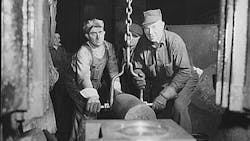The Competitive Edge: The Manufacturing Industry: Looking Back to Move Forward
Americans often take for granted the relationship between our high living standards and our remarkable manufacturing sector. Take a look around you right now -- you live in a world filled with products that make your life better, and wherever these goods were produced, chances are they are the descendants of American ingenuity.
As the Manufacturers Alliance for Productivity and Innovation celebrates its 80th anniversary this year, we reflect on the progress and success of the U.S. manufacturing sector. MAPI and its members have contributed to countless vital moments in American history, facilitating growth, modernization and prosperity. It is fascinating to explore where our members served at the forefront and behind the scenes of history.
Being Part of History
MAPI was established in the throes of the Great Depression, a time when companies had to scramble to keep pace or face extinction. One great example, Hubbell Inc. (IW500/278), went public in order to raise capital, and with an eye on the future began creating new products, including heavy-duty circuit-breaking devices and a series of locking connectors for industrial use. A.O. Smith Corp. (IW500/380) patented the glass-lined water heater, improving hot water's affordability. Despite a weak economy, America's great manufacturers were poised for a comeback.
See Also: Lean Manufacturing Leadership Best Practices
In the year after Japan's attack on Pearl Harbor, sales of new cars were banned to save steel, the country began rationing gasoline, and companies refocused their efforts in order to provide for soldiers at war while supporting the homefront. Lincoln Electric (IW500/291) hired women and minorities for the first time to keep up with demand. Hubbell Inc. manufactured electrical components for military vehicles while continuing to meet demand at home. Several companies experienced a shift in sales toward wartime goods, including Rockwell Automation (IW500/165), McKenna Metals [now Kennametal (IW500/301)] and Textron (IW500/98). This uptick in manufacturing paved the way for significant economic improvement and for the United States' rise to become the top industrial power for the remainder of the century.
After World War II, the nation entered a new period of economic growth. Demand for new homes led to increased production, and companies diversified. Briggs & Stratton (IW500/363) introduced home-owners to the first lightweight aluminum engine for lawnmowers, a luxury turned necessity as suburbs grew.
America's trip to the moon was a historical endeavor made possible through U.S. manufacturing prowess. Effectively ending the space race between the United States and the Soviet Union, the successful Apollo 11 space flight in 1969 achieved President Kennedy's goal of safely landing a man on the moon. Behind the scenes of this accomplishment were two MAPI members: Springs manufactured by Barnes Group Inc. (IW500/484) -- then known as Associated Spring Corp. -- were onboard the spacecraft; and Caterpillar (IW500/18) engines delivered power for communications between the shuttle and NASA's tracking stations, making it possible for Neil Armstrong's famous words to be heard.
While the United States navigated the Civil Rights movement, the Vietnam War, the Cold War and other political change and unpredictability, its manufacturing sector welcomed its own set of changes as global trade evolved and expanded. By the late 1970s, U.S. manufacturing employment reached its high watermark of 19.5 million workers. Between 1972 and 1981, Kennametal saw an increase in its share of foreign sales from 17% to 34%. After encountering challenges during the 1980s, Lincoln Electric strategized to achieve renewed growth; by its centennial in 1995, the company surpassed the $1 billion sales threshold.
The Future of Manufacturing
Since 2000, U.S. manufacturers have faced some of their greatest challenges -- including two serious recessions, the rise of China as a low-cost competitor, rapidly changing technologies that require a tech-savvy workforce, and dramatically changing demographics. The sector lost 6 million jobs since 2001 and has shrunk to less than 12% of national GDP.
| Take a tour of the most significant advances in manufacturing leadership and management history at www.iw.com/manufacturing-timeline. |
But it's also on the verge of a renaissance. MAPI's main purpose -- helping keep the U.S. manufacturing industry competitive -- hasn't changed. We proudly support our members' successes by providing a platform on which to exchange ideas and improve competitiveness in today's global market.
Stephen Gold is president and CEO of the Manufacturers Alliance for Productivity and Innovation (www.mapi.net). Jessica Larkin provided research assistance for this column.
About the Author

Stephen Gold
President and Chief Executive Officer, Manufacturers Alliance
Stephen Gold is president and CEO of Manufacturers Alliance. Previously, Gold served as senior vice president of operations for the National Electrical Manufacturers Association (NEMA) where he provided management oversight of the trade association’s 50 business units, member recruitment and retention, international operations, business development, and meeting planning. In addition, he was the staff lead for the Board-level Section Affairs Committee and Strategic Initiatives Committee.
Gold has an extensive background in business-related organizations and has represented U.S. manufacturers for much of his career. Prior to his work at NEMA, Gold spent five years at the National Association of Manufacturers (NAM), serving as vice president of allied associations and executive director of the Council of Manufacturing Associations. During his tenure he helped launch NAM’s Campaign for the Future of U.S. Manufacturing and served as executive director of the Coalition for the Future of U.S. Manufacturing.
Before joining NAM, Gold practiced law in Washington, D.C., at the former firm of Collier Shannon Scott, where he specialized in regulatory law, working in the consumer product safety practice group and on energy and environmental issues in the government relations practice group.
Gold has also served as associate director/communications director at the Tax Foundation in Washington and as director of public policy at Citizens for a Sound Economy, a free-market advocacy group. He began his career in Washington as a lobbyist for the Grocery Manufacturers of America and in the 1980s served in the communications department of Chief Justice Warren Burger’s Commission on the Bicentennial of the U.S. Constitution.
Gold holds a Juris Doctor (cum laude) from George Mason University School of Law, a master of arts degree in history from George Washington University, and a bachelor of science degree (magna cum laude) in history from Arizona State University. He is a Certified Association Executive (CAE).
